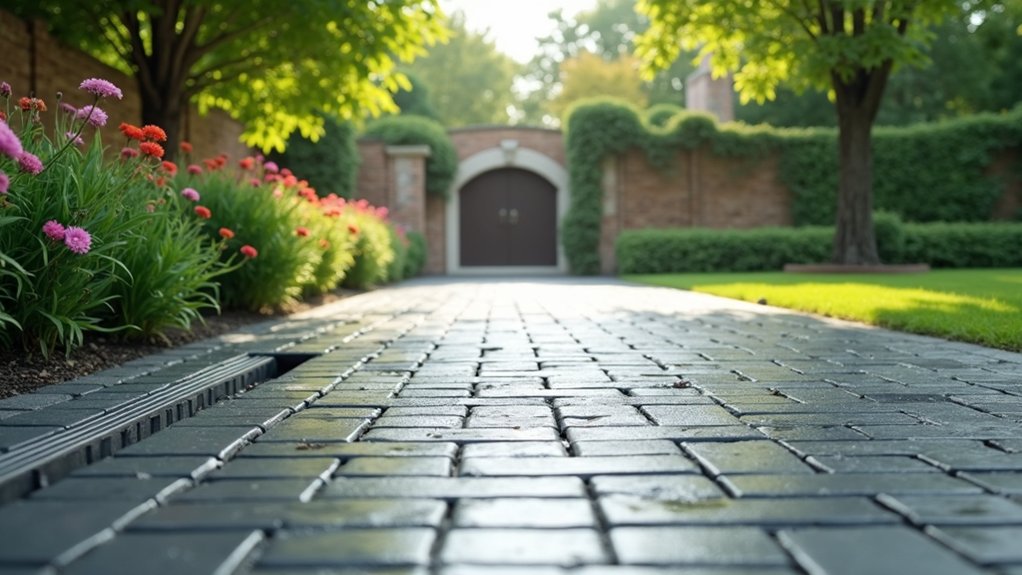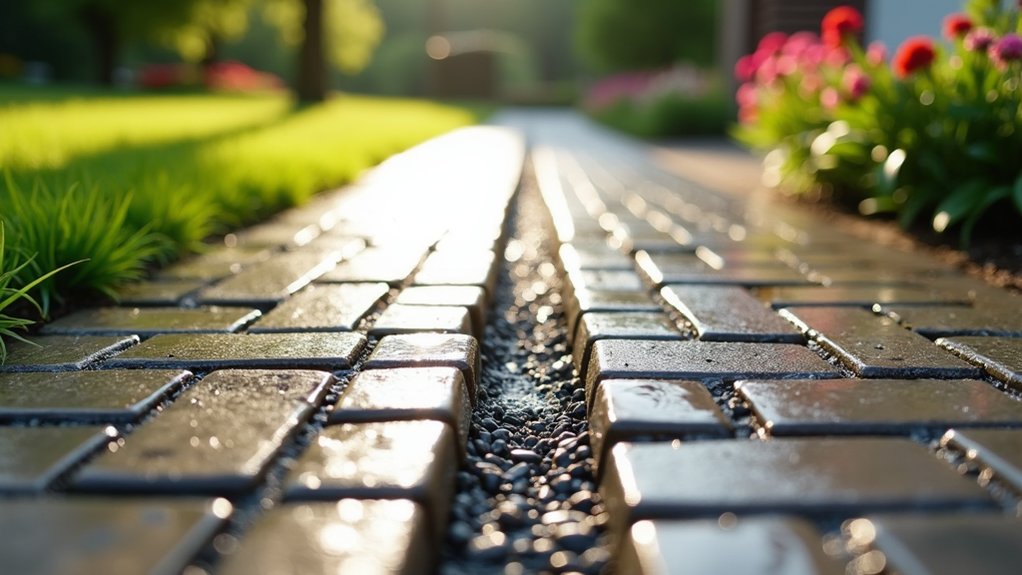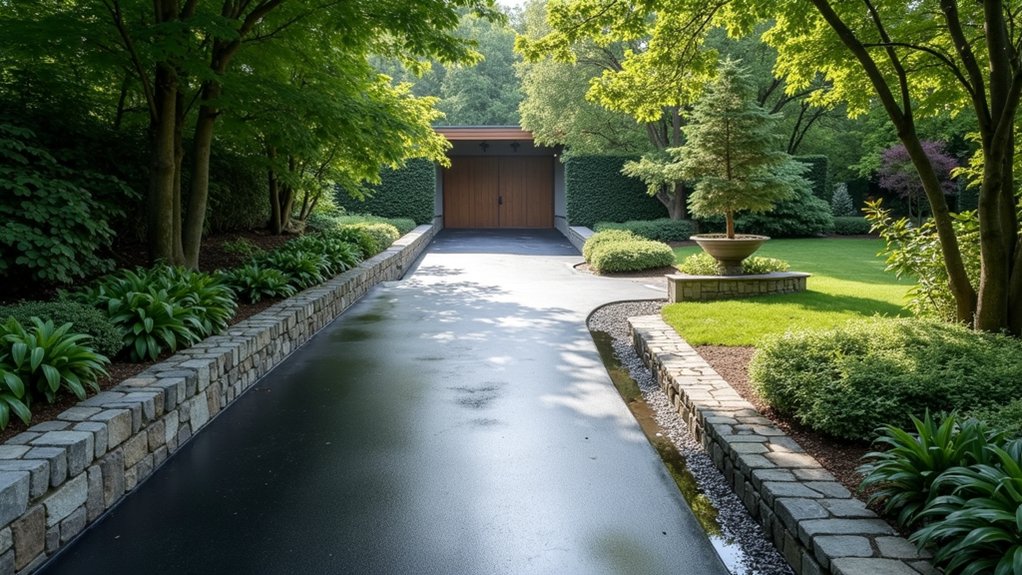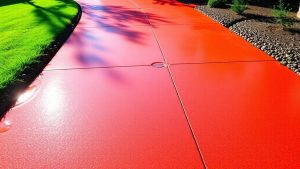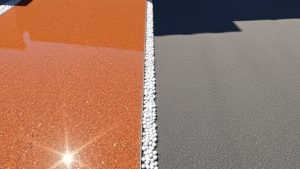If your driveway is over 5m², UK regulations state that you must have proper drainage to manage surface water and prevent flooding. Consider using permeable materials or directing water to garden areas to comply. If you opt for non-permeable surfaces, you may need planning permission unless you have adequate drainage in place. Not following these rules can result in fines and enforcement actions. To ensure your driveway meets legal standards and functions properly, look into effective drainage solutions and design options.
Table of Contents
ToggleKey Takeaways
In the UK, if your driveway is larger than 5m², it must have proper drainage to handle surface water runoff and avoid flooding. For example, if you’re laying down a block-paved driveway, you’ll need a drainage system. On the other hand, if you opt for permeable materials like gravel, you won’t need any drainage systems.
Driveways that are 5m² or smaller are exempt from these regulations, making it easier for homeowners to comply. Having effective drainage is crucial not only for protecting your property from water damage but also for environmental sustainability, as it helps filter water and prevent soil erosion.
Remember to regularly maintain and inspect your drainage systems to keep them functioning properly and to avoid costly problems down the line.
Legal Requirements for Driveway Drainage
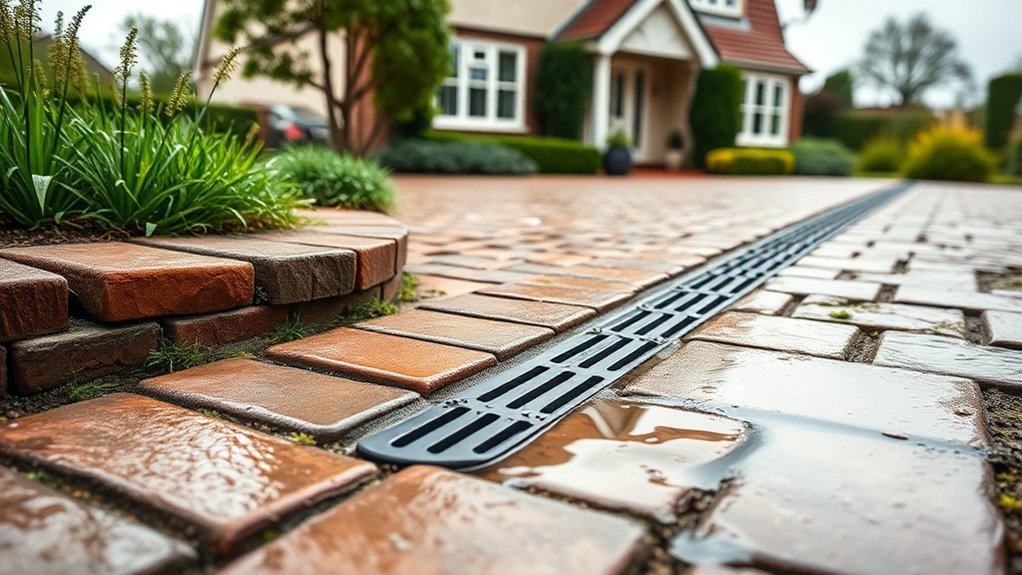
If you’re planning to install or replace a driveway larger than 5m² in the UK, it’s important to know the legal drainage requirements.
Regulations require that these driveways have proper drainage to prevent flooding and manage surface water runoff. You can use porous materials, which allow water to soak through, or direct water to garden areas. If you choose non-permeable surfaces, you’ll need planning permission unless you have compliant drainage systems in place. Remember, you can’t channel water into public drains without the right permissions. Additionally, proper drainage is essential to avoid the absorption of pollutants by non-porous materials, which can risk water system contamination. Implementing SuDS drainage solutions can further enhance the effectiveness of your driveway’s drainage system.
Failure to comply can result in fines, enforcement actions, or the need to retrofit your driveway. Making sure your driveway meets these requirements is crucial for protecting your property and avoiding future headaches.
Exemptions From Drainage Regulations
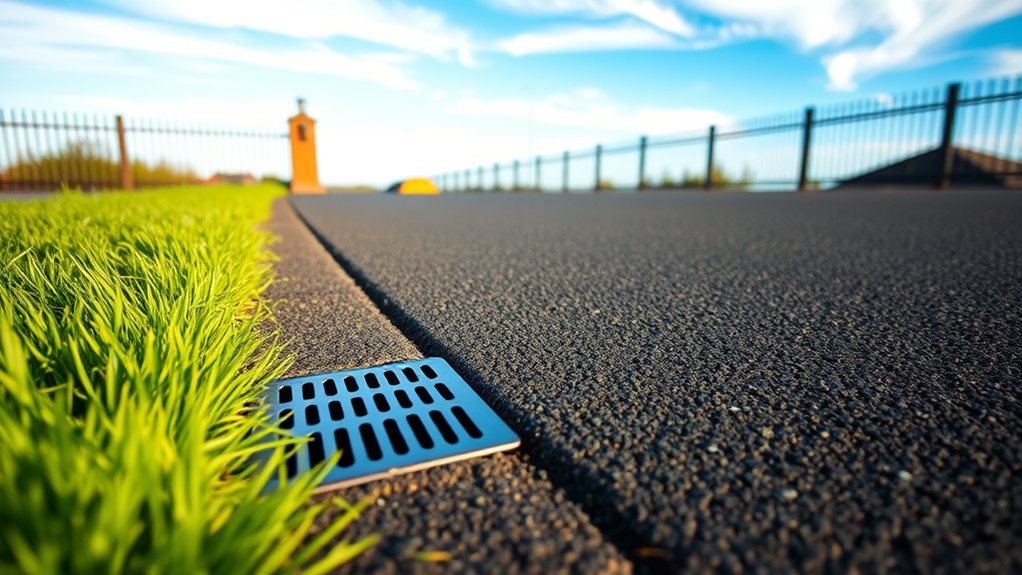
Understanding drainage regulations is crucial for driveway installation, but there are several exemptions that can make compliance easier. Here’s a straightforward overview of key exemptions:
| Exemption Type | Details |
|---|---|
| Permeable Materials | Driveways made from permeable surfaces, such as gravel or certain types of block paving, do not need drainage systems. These materials effectively manage stormwater runoff, reducing the need for additional drainage solutions. |
| Natural Drainage | If rainwater is directed towards lawns or borders, you won’t need to install additional drainage. |
| Size Limitations | Driveways that are 5m² or smaller are exempt from drainage regulations. Proper drainage solutions are essential for preventing flooding caused by excessive surface water. |
Importance of Proper Driveway Drainage
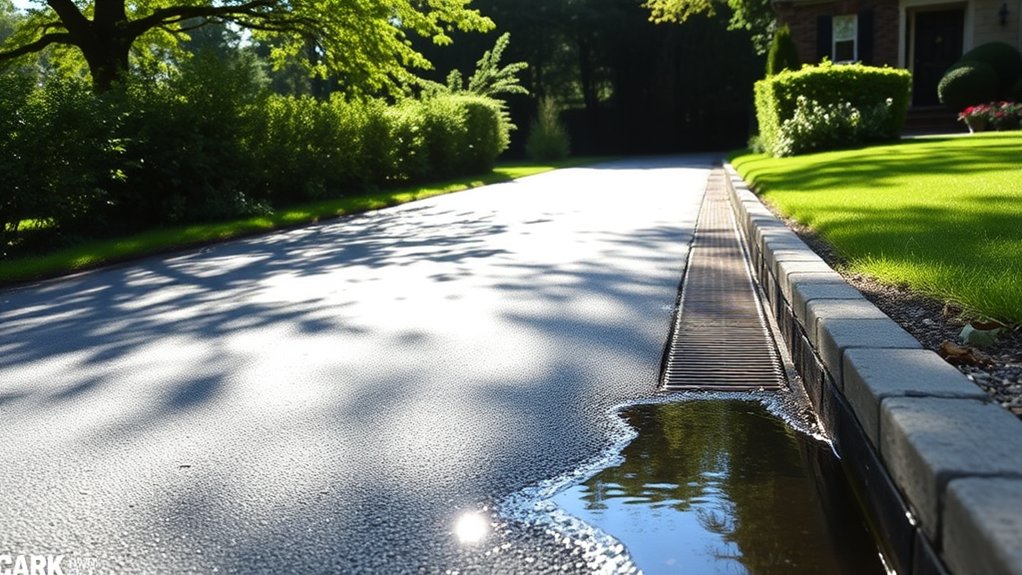
Proper driveway drainage is crucial for several reasons. Firstly, effective drainage helps prevent flooding by redirecting surface water, which protects your property from damage and benefits the surrounding area. For instance, if a heavy downpour occurs, good drainage can keep water from pooling on your driveway or flooding neighbouring properties.
Additionally, proper drainage addresses environmental issues by filtering water through permeable surfaces. This process reduces pollutants entering local waterways, which is vital for maintaining healthy ecosystems. Effective drainage solutions can also help prevent water accumulation that may weaken your driveway’s structure. Compliance with UK regulations also means you avoid costly planning permissions, making it a practical choice for homeowners. Furthermore, proper planning permission ensures that your driveway meets local regulations, which can help avoid future legal complications.
Moreover, maintaining proper drainage supports groundwater recharge and prevents soil erosion, contributing to sustainable practices that can help combat climate change.
Ultimately, a well-drained driveway isn’t just about protecting your property; it’s about safeguarding the environment and promoting community wellbeing.
Types of Driveway Materials and Their Impact
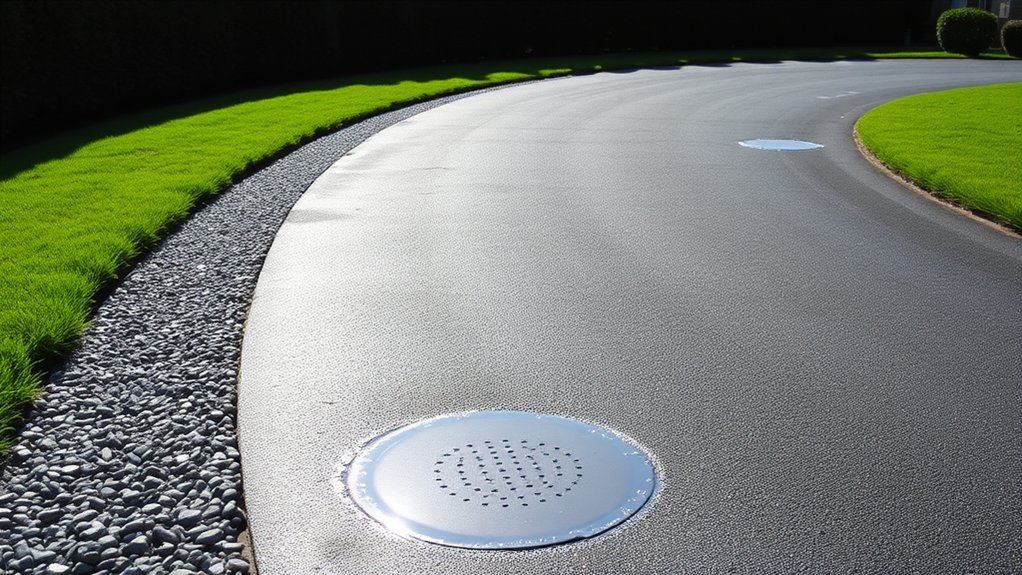
Choosing the right driveway material is crucial for effective water management and functionality. Each material has its own impact on aesthetics and longevity, which can influence your drainage requirements.
Here are some common options:
- Asphalt (Tarmac): Durable and lasts 15–20 years, but is impermeable, which can lead to water pooling.
- Gravel: Cost-effective and permeable, allowing water to drain away, but it does require regular upkeep.
- Resin Bound: Eco-friendly and long-lasting (20–25 years), this option allows for natural drainage, reducing runoff issues.
- Concrete: Very durable (over 25 years), but generally impermeable, so proper drainage solutions are essential.
Selecting the right driveway material not only enhances the look of your property but also ensures efficient water management tailored to your needs.
Cost of Installing Drainage Systems
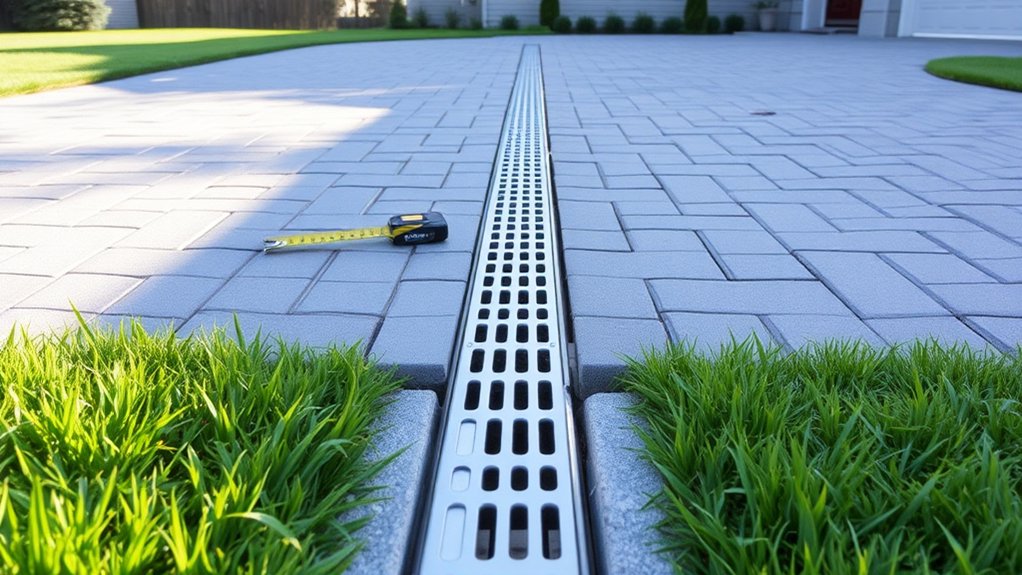
When looking at the cost of installing drainage systems for your driveway, prices can vary significantly due to several factors. Typically, costs range from £500 to £3,000, depending on the size and complexity of the system. For most homes, basic installations usually fall between £500 and £1,000.
Factors that influence the final price include the quality of materials, the complexity of the system, and your location. Larger systems will require more materials and labour, which can drive up costs.
If you choose to hire professionals, you should also budget for their expertise. Don’t forget to factor in additional costs for piping and paving, as these can increase the overall expense of your drainage installation.
Choosing Permeable Materials for Cost Savings
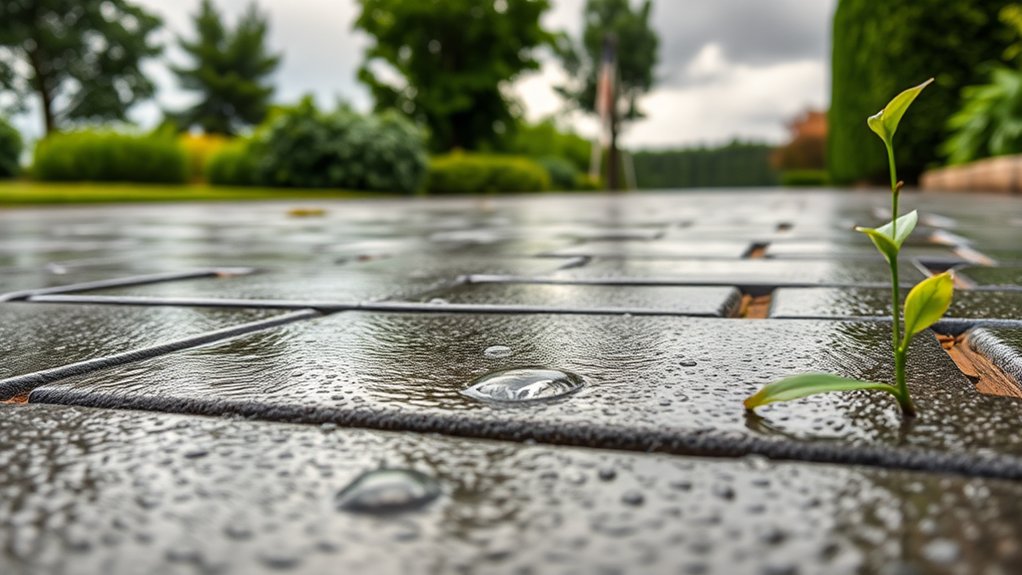
When selecting permeable materials for your driveway, consider budget-friendly options such as gravel or permeable block paving.
These choices not only lower your initial installation costs but also save you money in the long run by reducing drainage requirements and maintenance.
Cost-Effective Material Options
Opting for permeable materials for your driveway can save you money while meeting UK regulations.
Consider these budget-friendly options:
- Gravel: The cheapest choice, offering excellent permeability and low installation costs.
- Permeable block paving: Reasonably priced, it allows water to drain through, providing a good mix of durability and affordability.
- Porous asphalt: Similar in cost to standard asphalt, especially when considering installation with Sustainable Urban Drainage Systems (SUDS).
- Grasscrete: Moderately priced, it supports plant growth while ensuring effective drainage.
These materials not only reduce initial expenses but also help you sidestep extra costs associated with drainage compliance.
Make informed choices to get the most out of your investment.
Long-Term Savings Benefits
Choosing permeable materials for your driveway complies with UK regulations and offers significant long-term savings. These surfaces require less maintenance, which means fewer repairs and less frequent cleaning. This not only reduces the risk of water damage and surface wear but also extends the lifespan of your driveway.
| Benefit | Description | Long-Term Impact |
|---|---|---|
| Reduced Maintenance Costs | Less frequent cleaning and repairs | Lower overall expenses |
| Less Likely to Require Resurfacing | Enhanced durability and longevity | Cost-effective over time |
| Minimized Risk of Water Damage | Prevents structural issues | Protects property value |
| Lower Probability of Surface Wear | Prolongs material life | Reduces replacement costs |
| Less Need for Chemical Treatments | Eco-friendly maintenance | Sustainable choice |
Planning Permission and Driveway Regulations
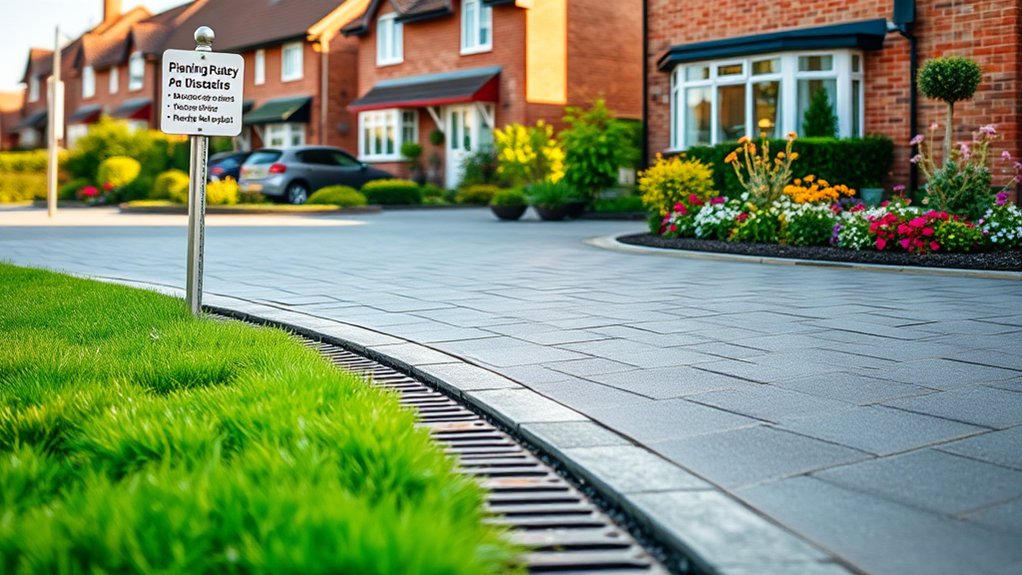
Understanding planning permission and driveway regulations is crucial for homeowners in the UK looking to improve their property. Generally, driveways are covered by permitted development rights, meaning you often won’t need planning permission.
However, local rules can differ, affecting both appearance and property value. Here are some key points to consider:
- Material Type: Using permeable materials like gravel usually doesn’t require permission.
- Size Matters: Driveways smaller than five square metres typically avoid regulations.
- Local Authority: Always check with your local council for specific guidelines.
- Visual Impact: Think about how your driveway will look in the context of your neighbourhood.
Being aware of these factors ensures compliance and helps maintain your property’s value while enhancing its curb appeal.
When Is Planning Permission Required?
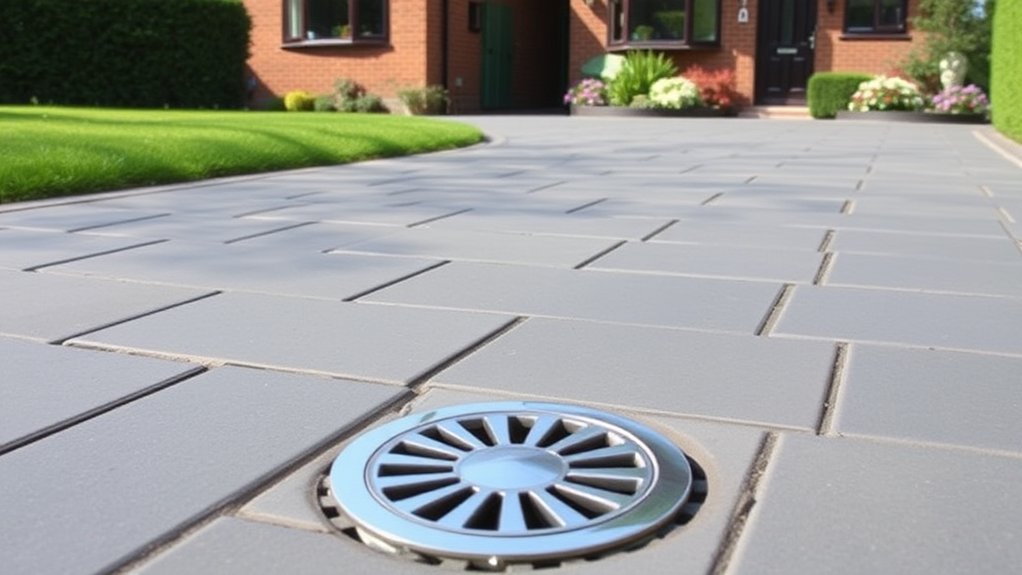
When do you need planning permission for your driveway?
You’ll need it if your project significantly changes the access point or width, or alters the footprint of your property.
If your driveway uses non-permeable materials and covers more than 5m², it typically requires approval.
Changing the slope or gradient of your driveway may also necessitate permission.
It’s crucial to ensure that rainwater drains into permeable areas; failing to do so could lead to restrictions.
Additionally, if your driveway is in a conservation area or near water bodies, local planning rules might require permission.
Always check with your local authority to avoid any compliance issues regarding drainage and environmental impact.
Designing Effective Drainage Systems
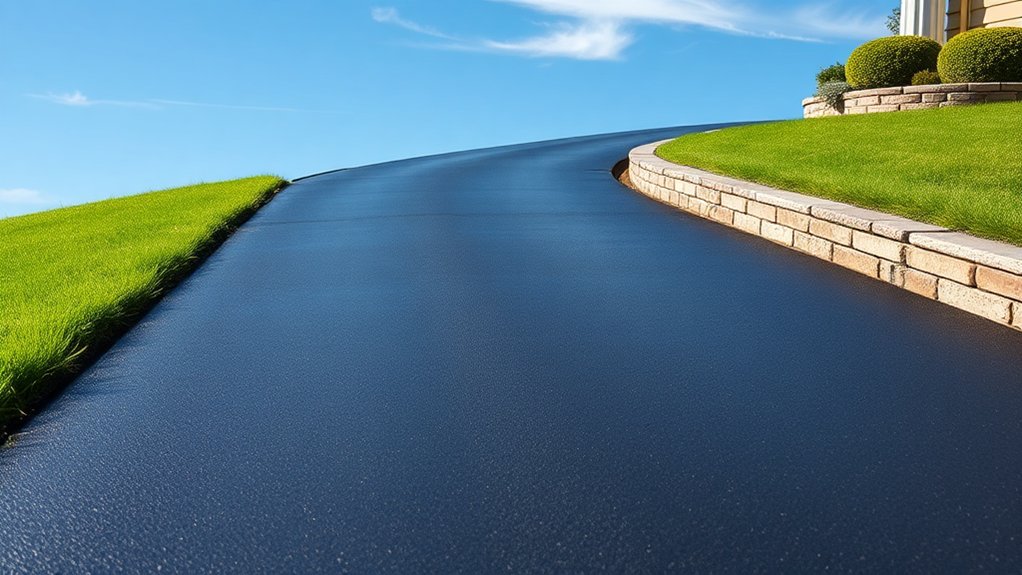
Effective drainage systems are vital for managing surface water on driveways, as they help prevent flooding and ensure safety.
Here are some key design principles for optimising drainage:
- Rapid Water Removal: Ensure that surface water is diverted swiftly and efficiently.
- Environmental Considerations: Design your system to reduce runoff and safeguard local wildlife and habitats.
- Driveway Durability: Incorporate drainage solutions that protect your driveway from water damage, prolonging its lifespan.
- Compatibility with Existing Systems: Work alongside local drainage networks to enhance overall water management.
Maintenance Best Practices for Driveway Drainage

To ensure effective driveway drainage, set up a regular inspection schedule to catch potential issues early.
Remove blockages promptly to prevent water backing up and causing damage.
Seasonal maintenance tips, such as clearing leaves and debris, can further improve the performance and lifespan of your drainage system.
Regular Inspection Schedule
Regular inspections of your driveway drainage system are crucial, particularly during heavy rainfall seasons. They ensure optimal performance and help prevent costly damage.
Here are some guidelines for inspection frequency:
- Seasonal Checks: Inspect more frequently in autumn and spring, as leaves and debris can cause blockages.
- Post-Storm Inspections: Always check the system after severe storms to ensure it’s functioning properly.
- High Traffic Areas: If your driveway sees a lot of use or is prone to flooding, increase the frequency of your inspections.
- Manufacturer Recommendations: Follow any specific schedules provided for your drainage components.
Keeping your drainage system in good condition will save you time and money in the long run.
Clear Blockages Promptly
After setting up a regular inspection schedule for your driveway drainage system, it’s crucial to quickly address any blockages that occur to keep everything functioning smoothly. Common causes of blockages include debris build-up, visible water pooling, and strange noises from drains. To prevent significant damage, act swiftly by removing debris and flushing out channels with water.
| Sign of Blockage | Immediate Action Required | Risk of Ignoring |
|---|---|---|
| Water pooling | Clear surface debris | Risk of flooding |
| Gurgling sounds | Use drain rods to dislodge | Potential structural damage |
| Mold growth | Inspect and clear downspouts | Attracts pests |
Implementing effective drainage solutions can help prevent future issues, ensuring your driveway remains safe and functional.
Seasonal Maintenance Tips
Maintaining your driveway drainage system throughout the seasons is crucial for optimal performance and can help avoid expensive repairs.
A structured seasonal maintenance routine will extend its lifespan. Regular cleaning and inspections are key.
Here are some tips:
- Spring: After winter, give your drainage system a thorough clean and check for any damage.
- Summer: Clean every two to three months and look out for leaks or blockages.
- Autumn: Clear away fallen leaves to prevent debris from clogging the drains.
- Winter: Ensure drains are free from obstructions to avoid freezing and ice build-up.
Staying on top of these tasks will help keep your drainage system in good shape all year round.
Environmental Considerations in Driveway Design
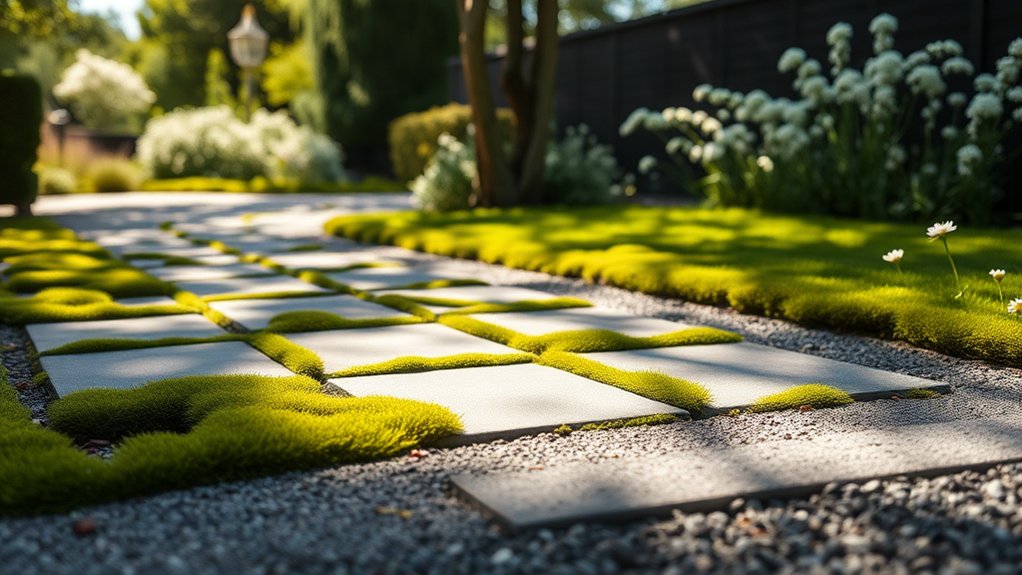
When designing a driveway, it’s important to consider its environmental impact. Good drainage can help reduce pollution and protect local ecosystems.
Using sustainable materials like permeable paving allows rainwater to filter through, cutting down on runoff and preventing harmful substances from entering rivers and streams.
Incorporating features such as rain gardens and soakaways can improve water absorption and reduce soil erosion.
Ensure your driveway directs water towards planted areas rather than storm drains to support habitat preservation.
By adopting these practices, you not only meet regulations but also help mitigate climate change by lessening the burden on urban drainage systems.
Thoughtful design choices can lead to a driveway that respects and protects the environment.
Frequently Asked Questions
How Can I Check if My Driveway Is Compliant With Regulations?
To check if your driveway complies with regulations, first examine the materials used and ensure there is a proper drainage system that directs water to permeable areas. It’s also important to confirm that the driveway slopes away from public pavements to prevent flooding and adhere to local guidelines.
What Are the Penalties for Not Having Proper Driveway Drainage?
If you lack proper drainage for your driveway, you could face fines and legal repercussions. Poor drainage may result in insurance complications, claims for environmental damage, and liability for accidents. This can significantly affect both the value and safety of your property. For example, standing water can lead to slips and trips, putting you at risk of costly claims.
Can I Install a Drainage System Myself?
You can install a drainage system yourself, but it’s essential to follow proper installation guidelines and check local regulations to avoid issues like flooding in the future. For instance, if you’re in a heavy rainfall area, ensure your system can handle the volume of water. Digging trenches and laying pipes may seem straightforward, but take your time to do it right. Always consider seeking professional advice if you’re uncertain about any aspect of the project.
How Do I Choose the Best Location for Drainage Installation?
To choose the best location for drainage installation, consider how the drainage will interact with your landscape. Ensure the slope directs water away from buildings, like your house or shed, to prevent flooding. Also, maintain clear access for future maintenance and avoid any obstacles, such as trees or fences, that could hinder repairs.
What Should I Do if My Driveway Floods Despite Having Drainage?
Did you know that more than 30% of driveway flooding is due to poor drainage maintenance? To prevent this, regularly inspect your drainage system, clear any blockages, and ensure your driveway has the correct slope to direct water away. For example, if you notice puddles forming after rain, it might be time to check your drains and adjust the slope. Keeping on top of these tasks can help you avoid flooding issues.
Conclusion
In summary, knowing your driveway’s drainage requirements is essential for both legal compliance and functionality. Assess the regulations and any available exemptions, and choose suitable materials to ensure effective drainage. Regular maintenance and consideration of environmental factors will also contribute to the longevity of your driveway. Whether you’re installing a new drainage system or upgrading an existing one, remember that careful planning, consistent upkeep, and informed design are key to a successful driveway. Don’t underestimate these elements; they are crucial for a durable and compliant surface.
Find effective strategies to prevent water pooling on your driveway and discover essential tips that will keep it dry and Read more
Learn why effective drainage is crucial for driveways and discover the regulations and best practices that could save you costly Read more
Properly managing drainage issues on your resin driveway can prevent costly repairs, but are you aware of the key factors Read more

